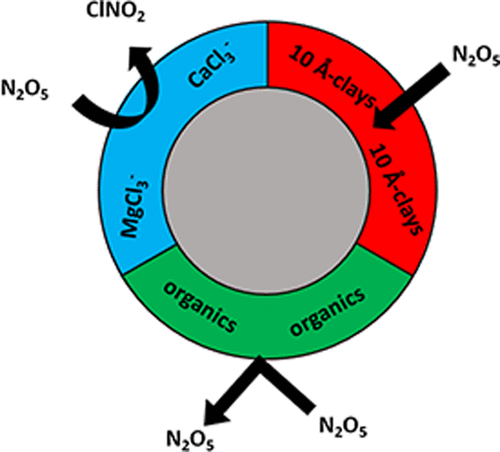当前位置:
X-MOL 学术
›
Environ. Sci. Technol.
›
论文详情
Our official English website, www.x-mol.net, welcomes your feedback! (Note: you will need to create a separate account there.)
The Role of Hydrates, Competing Chemical Constituents, and Surface Composition on ClNO2 Formation
Environmental Science & Technology ( IF 11.4 ) Pub Date : 2021-02-15 , DOI: 10.1021/acs.est.0c06067 Haley M. Royer 1 , Dhruv Mitroo 1 , Sarah M. Hayes 2 , Savannah M. Haas 3 , Kerri A. Pratt 3 , Patricia L. Blackwelder 4, 5 , Thomas E. Gill 6, 7 , Cassandra J. Gaston 1
Environmental Science & Technology ( IF 11.4 ) Pub Date : 2021-02-15 , DOI: 10.1021/acs.est.0c06067 Haley M. Royer 1 , Dhruv Mitroo 1 , Sarah M. Hayes 2 , Savannah M. Haas 3 , Kerri A. Pratt 3 , Patricia L. Blackwelder 4, 5 , Thomas E. Gill 6, 7 , Cassandra J. Gaston 1
Affiliation

|
Atomic chlorine (Cl•) affects air quality and atmospheric oxidizing capacity. Nitryl chloride (ClNO2) – a common Cl• source–forms when chloride-containing aerosols react with dinitrogen pentoxide (N2O5). A recent study showed that saline lakebed (playa) dust is an inland source of particulate chloride (Cl–) that generates high ClNO2. However, the underlying physiochemical factors responsible for observed yields are poorly understood. To elucidate these controlling factors, we utilized single particle and bulk techniques to determine the chemical composition and mineralogy of playa sediment and dust samples from the southwest United States. Single particle analysis shows trace highly hygroscopic magnesium and calcium Cl-containing minerals are present and likely facilitate ClNO2 formation at low humidity. Single particle and mineralogical analysis detected playa sediment organic matter that hinders N2O5 uptake as well as 10 Å-clay minerals (e.g., Illite) that compete with water and chloride for N2O5. Finally, we show that the composition of the aerosol surface, rather than the bulk, is critical in ClNO2 formation. These findings underscore the importance of mixing state, competing reactions, and surface chemistry on N2O5 uptake and ClNO2 yield for playa dusts and, likely, other aerosol systems. Therefore, consideration of particle surface composition is necessary to improve ClNO2 and air quality modeling.
中文翻译:

水合物,竞争性化学成分和表面组成对ClNO 2形成的作用
原子氯(Cl •)影响空气质量和大气氧化能力。当含氯化物的气溶胶与五氧化二氮(N 2 O 5)反应时,形成氯化亚硝酰氯(ClNO 2)–一种常见的Cl •来源。最近的一项研究表明,盐水湖床(滩)粉尘的颗粒状氯(氯内陆源- ),其产生高ClNO 2。但是,对导致观察到的产量的潜在理化因素了解得很少。为了阐明这些控制因素,我们利用单颗粒和散装技术确定了美国西南部普拉亚沉积物和粉尘样品的化学成分和矿物学。单颗粒分析显示存在微量的高度吸湿性的镁和钙含Cl的矿物质,并可能有助于在低湿度下形成ClNO 2。单个颗粒和矿物学分析可检测到阻碍N 2 O 5吸收的沉积物有机质以及与水和氯化物竞争N 2 O 5的10Å粘土矿物(例如Illite)。最后,我们表明,气溶胶表面的组成而不是体积对于ClNO 2的形成至关重要。这些发现突显了混合态,竞争反应和表面化学对粉尘和其他气溶胶系统中N 2 O 5吸收和ClNO 2收率的重要性。因此,必须考虑颗粒表面组成以改善ClNO 2和空气质量模型。
更新日期:2021-03-02
中文翻译:

水合物,竞争性化学成分和表面组成对ClNO 2形成的作用
原子氯(Cl •)影响空气质量和大气氧化能力。当含氯化物的气溶胶与五氧化二氮(N 2 O 5)反应时,形成氯化亚硝酰氯(ClNO 2)–一种常见的Cl •来源。最近的一项研究表明,盐水湖床(滩)粉尘的颗粒状氯(氯内陆源- ),其产生高ClNO 2。但是,对导致观察到的产量的潜在理化因素了解得很少。为了阐明这些控制因素,我们利用单颗粒和散装技术确定了美国西南部普拉亚沉积物和粉尘样品的化学成分和矿物学。单颗粒分析显示存在微量的高度吸湿性的镁和钙含Cl的矿物质,并可能有助于在低湿度下形成ClNO 2。单个颗粒和矿物学分析可检测到阻碍N 2 O 5吸收的沉积物有机质以及与水和氯化物竞争N 2 O 5的10Å粘土矿物(例如Illite)。最后,我们表明,气溶胶表面的组成而不是体积对于ClNO 2的形成至关重要。这些发现突显了混合态,竞争反应和表面化学对粉尘和其他气溶胶系统中N 2 O 5吸收和ClNO 2收率的重要性。因此,必须考虑颗粒表面组成以改善ClNO 2和空气质量模型。



























 京公网安备 11010802027423号
京公网安备 11010802027423号